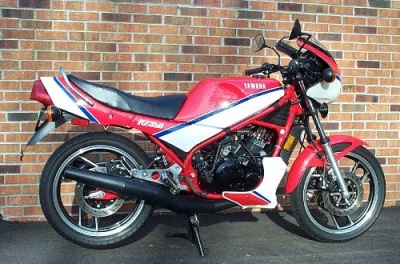
Yamaha Year Codes
This is a simple chart of what letters correspond to what years for Yamaha models. You ever wonder why some people refer to your 82 XJ650 Maxim as a XJ650J and why is it called XJ650K for the next year even though it is the same generation? Well, this chart should never make you ask again. Also below is a break down and explanation of model coding.
| A- | 1974 |
| B- | 1975 |
| C- | 1976 |
| D- | 1977 |
| E- | 1978 |
| F- | 1979 |
| G- | 1980 |
| H- | 1981 |
| J- | 1982 |
| K- | 1983 |
| L- | 1984 |
| N- | 1985 |
| S- | 1986 |
| T- | 1987 |
| U- | 1988 |
| W- | 1989 |
| A- | 1990 |
| B- | 1991 |
| D- | 1992 |
| E- | 1993 |
| F- | 1994 |
| G- | 1995 |
| H- | 1996 |
| J- | 1997 |
| K- | 1998 |
| L- | 1999 |
| M- | 2000 |
| N- | 2001 |
| P- | 2002 |
| R- | 2003 |
| S- | 2004 |
| T- | 2005 |
| V- | 2006 |
| W- | 2007 |
| X- | 2008 |
| Y- | 2009 |
| Z- | 2010 |
| A- | 2011 |
| B- | 2012 |
| D- | 2013 |
| E- | 2014 |
Breaking Down The Model
The basic way to break down a bikes model is seperate it's basic parts. Lets take the model below as an example.
'82 XJ650RJ Seca
XJ
650
R
J
Seca
Full Name
Engine Family
cc
Ext Type
Year
Model Name
As you can see above the first section is the entire name '82 XJ650RJ Seca and this tells you all you need to know to
basically identify this bike and what parts it uses.
___________________________________________________________________________________
The second section shows you the first break-down is the engine family this bike belongs
to. In this case it is the XJ family which basically is DOHC four stroke engines with in-line cylinders.
It is not the only Yamaha motor family with these characteristics.
___________________________________________________________________________________
The third section shows the second break-down which is it's listed cc (cubic
centimeters) range which is 650.
Typically based on a round-up or round-down of the actual cc of the engine.
In this bikes case the actual size is 653cc.
___________________________________________________________________________________
The fourth section shows the third break-down which is bike extended model type. In this case it is a
R model which tells us it is a Seca. If it did not have any letter in this
section it would be the standard model that is called the Maxim and be
called a '82 XJ650J. Typically when no extended type code is shown it breaks
down to the first version, or base model of the bike. The extension type is
almost always a custom or special version of the first model that was
offered. I used the XJ650 specifically because there are 3 total versions in
'82. First was the standard Maxim model XJ650J, the second was the XJ650RJ
which was the Seca, and last was the XJ650LJ which was the Seca Turbo. You
have to watch Yamaha extended codes because they are not literally for just
that style like some other brand bikes. A example is the '81 XJ650LH which
you would assume would be the same as the XJ650LJ Seca Turbo '82 just one
year earlier, but this is wrong. It is actually the Midnight Maxim version.
So the L has to be used along with the year code J or H to complete the
bikes description.
___________________________________________________________________________________
The fifth section tells us the final break-down of the code which is the year. In this case it is a
J which was
applied to all '82 model Yamaha motorcycles. Like the last area you read,
you must use this code in combination with the complete name. An example of
this would be XJ600SJ Seca 2 which you could assume is another '82 model when in
fact it is actually a '97 model. Yamaha recycled the letters starting in
1990 and again in 2011. Letters like A were used 3 times over the years!
Other letters like C and U were only used once total and XYZ only used after they
recycled the letters. If you ever see a C at the end of any model later than '76 it
is a California model and the C would be in addition to the normal code and
always at the end.
Yamaha is not the easiest code to memorize so bookmark this chart if your into them.
Before using this system when Yamaha was a lot less diverse with their
street bike offerings they simply used a ABC system to show the year and did
not use the final section below that incorporates the number too. An example
would be a Yamaha 350cc twin R5. It progresses '70 R5A, '71 R5B, '72 R5C.
Yamaha used a lot of simple alpha-numeric names for early bikes that had no
cc reference so this was the best way, at the time, to state the model. It
was much easier to reference a model with the basic cc in the name. For
instance the R5 you just have to know it is a 350 where as the following
model was a '73 RD350 which is obvious as a 350cc. The earlier you get
the weirder the system gets.
___________________________________________________________________________________
The final section
is simply the actual name of the model type. Yamaha uses names to attach to
various models like the Maxim made 400cc to 1100cc, Seca made 400cc to
900cc, Virago's which are Yamaha's first generation V-Twins, and many
others. They also may have a model name that includes the size
like a '98 XVS650AK which can be referred to simply as a '98 650 V-Star
Classic.
Making sure you learn what the entire model name is for your bike will ensure you do not get incorrect parts from your supplier. A perfect example of a mistake would be your in need of a clutch cable for your '82 XJ650RJ Seca. If you simply ask the supplier for a '82 XJ650 clutch cable, and disregard the type, it will not fit your model if the bike is stock. If you buy a cable made for a regular XJ650, which is a standard Maxim model, the cable will be too long for the R models shorter set of handlebars. That means another trip to the supplier, or even worse, being stuck with it.

